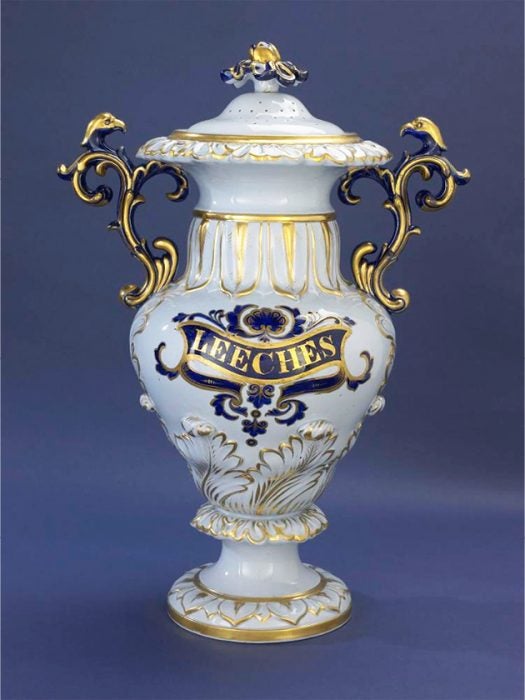“There is no doubt that the medicinal leech is one of the most beautiful of animals,” wrote British zoologist Arthur Everett Shipley in 1914. Yes, the leech: blood-sucking, marsh-dwelling, annullated worm, faceless except for its rings of teeth. Yet in Shipley’s eyes, leeches were magnificent. Their bodies were works of art, marked with “a delicious harmony of browns and greens and blacks and yellows, a beautiful soft symphony of velvety browns and greens and blacks.” Their movements were graceful, even “seductive” (his words).
Shipley was not the only Brit to harbor warm, fuzzy feelings for this decidedly unwarm, unfuzzy creature. After undergoing a bloodletting to treat a dangerous illness, the eminent lawyer Lord Thomas Erskine struck up a friendship with the two leeches that had been used in his treatment. He brought them home, named them Home and Cline, and housed them permanently in a glass of water in his library. According to his friend Sir Sam Romilly, he was sure the two leeches “knew him and were grateful to him.” He even consulted the pair occasionally on tricky legal cases, divining their answers based on their movements in the glass.
Shipley and Erskine, eccentric though they may sound, were simply participating in a bizarre cultural phenomenon that swept through Europe in the nineteenth century: leech mania. Bloodletting was a common medical treatment for millennia, but it wasn’t until the nineteenth century that doctors began to abandon the lancet for the leech.
This was probably for the best, as leeching was safer, gentler, and less painful than slicing open a vein. Yet at times the enthusiasm for leeches reached truly terrifying heights. The French physician François-Joseph-Victor Broussais was known as “le vampire de la médecine” for his habit of bleeding patients with fifty leeches at a time, draining up to eighty percent of their blood. During his tenure at Val-de-Grâce military hospital, every new patient admitted was given a treatment of thirty leeches, regardless of their symptoms. Sometimes soldiers were bled with so many leeches at a time that they appeared to be covered in glittering chainmail.
At the height of Broussais’ influence, France imported more than thirty-three million leeches a year. For a time, it was the height of fashion for women to bedeck themselves in leech-themed embroidery. It seems Shipley was not alone in appreciating the “soft symphony” of the leech’s coloring. The fashion was called, appropriately, dressing “à la Broussais.”
Weekly Digest
Sympathy for leeches was at an all-time high. You can detect it in the way that people spoke about the creatures: During a leech shortage in London, a shipment of leeches from India were described as “willing and even anxious to do their duty.” Not hungry, but willing; not feeding, but doing their duty, as if leeches sucked blood out of the goodness of their hearts. By contrast, the horse leech, a species not used in medicine, was said to be “barbarous” and “incapable of civility.” A stark contrast, presumably, to the gracious and civilized medical leech, the doctor’s worthy collaborator.

The demand for leeches quickly made the creatures a valuable commodity. Apothecaries displayed their precious merchandise in gorgeous, ornate leech-jars. Outside, the jars were ornamented with gilt swirls and scrolls. Inside, they were filled with rainwater, pebbles, and moss, to make the leeches feel more at home.
Meanwhile, poor leech-gatherers earned their living by wading into muddy pools, skirts or pants hiked up, and waiting for bites. A thankless job, but one they pursued with enough dedication to drive the medical leech to the brink of extinction. Prized and pampered as a commodity, the leech became a victim of its own popularity.







